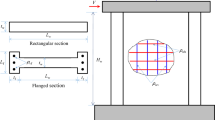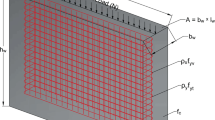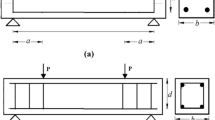Abstract
Reinforced concrete (RC) shear walls are very commonly used in buildings and nuclear power plants. Shear strength is one of the critical parameters in the design of RC walls, especially considering the influence of horizontal loads such as wind or earthquakes. The objective of this paper is to build machine learning (ML) models to predict the shear capacity of rectangular RC squat walls. A dataset of 312 experimental results in previous studies were collected and used for training ML models. Six ML models including Artificial neural network-Levenberg Marquardt (ANN-LM), Artificial neural network-Bayesian regularization (ANN-BR), Artificial neural network-Gene algorithm (ANN-GA), Adaptive neuro fuzzy inference system (ANFIS), Random Forest (RF), and Gradient boosting regression tree (GBRT), were developed to predict the shear strength of RC walls. The prediction results of the proposed ML models were compared with that from eight empirical formulas in design standards and published studies. From the comparison results, the RF and GBRT models predicted the shear capacity of RC walls much more accurately than existing formulas. Furthermore, a graphical user interface has been established based on an efficient ML model to facilitate the actual design process of rectangular RC short walls.














Similar content being viewed by others
References
ACI-318 (2014). ACI 318–14: Building Code Requirements for Structural Concrete and Commentary. American Concrete Institution Indianapolis, IN, USA.
Adorno-Bonilla, C.M. (2016). Shear strength and displacement capacity of squat reinforced concrete shear walls. (UNIVERSITY OF PUERTO RICO MAYAGÜEZ CAMPUS).
ASCE, SEI-43-05. (2005). Seismic design criteria for structures, Systems, and Components in Nuclear Facilities. American Society of Civil Engineers.
Barda, F., Hanson, J. M., & Corley, W. G. (1977). Shear strength of low-rise walls with boundary elements. Special Publication, 53, 149–202.
Breiman, L. (2001). Random Forests. Machine Learning, 45, 5–32.
Burden, F., & Winkler, D. (2008). Bayesian regularization of neural networks. In D. J. Livingstone (Ed.), Artificial neural networks. Methods in molecular biology™ (Vol. 458, pp. 23–42). Humana Press. https://doi.org/10.1007/978-1-60327-101-1_3.
Chatterjee, S., Sarkar, S., Hore, S., Dey, N., Ashour, A. S., & Balas, V. E. (2017). Particle swarm optimization trained neural network for structural failure prediction of multistoried RC buildings. Neural Computing and Applications, 28, 2005–2016.
Chen, T., and Guestrin, C. (2016). Xgboost: A scalable tree boosting system. pp. 785–794.
Chen, X., Fu, J., Yao, J., & Gan, J. (2018). Prediction of shear strength for squat RC walls using a hybrid ANN–PSO model. Engineering with Computers, 34, 367–383.
Chou, J.-S., Liu, C.-Y., Prayogo, H., Khasani, R. R., Gho, D., & Lalitan, G. G. (2022). Predicting nominal shear capacity of reinforced concrete wall in building by metaheuristics-optimized machine learning. Journal of Building Engineering, 61, 105046.
EN-1998–1 (2004). Eurocode 8: Design of Structures for Earthquake Resistance - Part 1: General Rules. Seismic Actions and Rules for Buildings.
Falcone, R., Lima, C., & Martinelli, E. (2020). Soft computing techniques in structural and earthquake engineering: A literature review. Engineering Structures, 207, 110269.
Farzinpour, A., Dehcheshmeh, E. M., Broujerdian, V., Esfahani, S. N., & Gandomi, A. H. (2023). Efficient boosting-based algorithms for shear strength prediction of squat RC walls. Case Studies in Construction Materials, 18, e01928.
Gulec, C. K., & Whittaker, A. S. (2011). Empirical equations for peak shear strength of low aspect ratio reinforced concrete walls. ACI Structural Journal, 108, 80–89.
Gulec, C. K., Whittaker, A. S., & Stojadinovic, B. (2008). Shear strength of squat rectangular reinforced concrete walls. ACI Structural Journal, 105, 488.
Holland, J. H. (1992). Genetic Algorithms. Scientific American, 267, 66–73.
Jang, J.-S. (1993). ANFIS: Adaptive-network-based fuzzy inference system. IEEE Transactions on Systems, Man, and Cybernetics, 23, 665–685.
Kassem, W. (2015). Shear strength of squat walls: A strut-and-tie model and closed-form design formula. Engineering Structures, 84, 430–438.
Kaveh, A., Dadras Eslamlou, A., Javadi, S., & Geran Malek, N. (2021). Machine learning regression approaches for predicting the ultimate buckling load of variable-stiffness composite cylinders. Acta Mechanica, 232, 921–931.
Kaveh, A., Eskandari, A., and Movasat, M. (2023). Buckling resistance prediction of high-strength steel columns using metaheuristic-trained artificial neural networks. (Elsevier), pp. 104853.
Kaveh, A., and Khavaninzadeh, N. (2023). Efficient training of two ANNs using four meta-heuristic algorithms for predicting the FRP strength. (Elsevier), pp. 256–272.
Keshtegar, B., Nehdi, M. L., Trung, N.-T., & Kolahchi, R. (2021). Predicting load capacity of shear walls using SVR–RSM model. Applied Soft Computing, 112, 107739.
Mangalathu, S., Jang, H., Hwang, S.-H., & Jeon, J.-S. (2020). Data-driven machine-learning-based seismic failure mode identification of reinforced concrete shear walls. Engineering Structures, 208, 110331.
Moradi, M. J., & Hariri-Ardebili, M. A. (2019). Developing a library of shear walls database and the neural network based predictive meta-model. Applied Sciences, 9, 2562.
Nguyen, D.-D., Tran, V.-L., Ha, D.-H., Nguyen, V.-Q., & Lee, T.-H. (2021). A machine learning-based formulation for predicting shear capacity of squat flanged RC walls. Structures, 29, 1734–1747.
Ranganathan, A. (2004). The levenberg-marquardt algorithm. Tutoral on LM Algorithm, 11, 101–110.
Sánchez-Alejandre, A., & Alcocer, S. M. (2010). Shear strength of squat reinforced concrete walls subjected to earthquake loading—trends and models. Engineering Structures, 32, 2466–2476.
Tariq, M., Khan, A., Ullah, A., Zamin, B., Kashyzadeh, K. R., & Ahmad, M. (2022). Gene Expression Programming for Estimating Shear Strength of RC Squat Wall. Buildings, 12, 918.
Thai, H.-T. (2022). Machine learning for structural engineering: A state-of-the-art review. (Elsevier), pp. 448–491.
Wood, S. L. (1990). Shear strength of low-rise reinforced concrete walls. Structural Journal, 87, 99–107.
Funding
No funding was used in this study.
Author information
Authors and Affiliations
Contributions
T-HN: conceptualization, software, visualization, writing—original draft. D-DN: methodology, formal analysis, validation, writing—original draft, writing—review & editing, supervision.
Corresponding author
Ethics declarations
Conflict of interest
The authors declare that they have no conflicts of interest.
Additional information
Publisher's Note
Springer Nature remains neutral with regard to jurisdictional claims in published maps and institutional affiliations.
Rights and permissions
Springer Nature or its licensor (e.g. a society or other partner) holds exclusive rights to this article under a publishing agreement with the author(s) or other rightsholder(s); author self-archiving of the accepted manuscript version of this article is solely governed by the terms of such publishing agreement and applicable law.
About this article
Cite this article
Nguyen, TH., Nguyen, DD. Improved data-driven models for estimating shear capacity of squat rectangular reinforced concrete walls. Asian J Civ Eng 25, 2729–2742 (2024). https://doi.org/10.1007/s42107-023-00941-6
Received:
Accepted:
Published:
Issue Date:
DOI: https://doi.org/10.1007/s42107-023-00941-6




